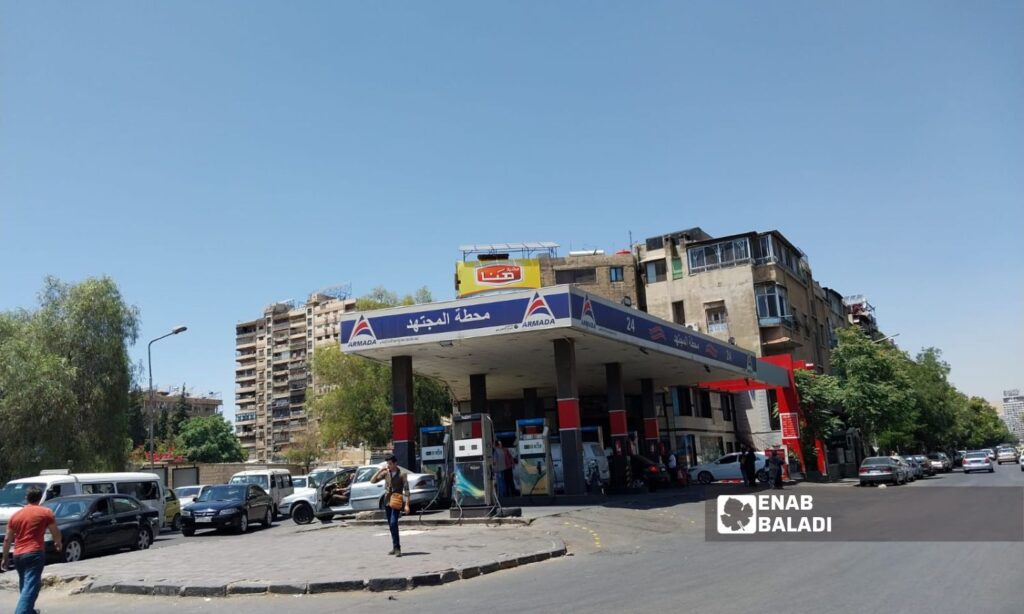Fuel prices in Syria have reached record levels this year, including both subsidized and unsubsidized fuel, amid government austerity measures in the sale of these products and the significant decrease in the purchasing power of the population.
The terms “subsidized” and “unsubsidized” have emerged in relation to petroleum products after linking their sale to a “smart card,” whereby each person receives specific quantities within different time frames, depending on the availability of these products. This has led to the emergence of a “black market” selling the same products at higher prices due to high demand and limited quantities of “subsidized” products.
Officials in the Syrian regime government usually complain about inadequate fuel supplies due to most oil fields being outside the regime-controlled areas. They attribute the poor provision of services, such as prolonged power outages, to the lack of fuel supplies.
The latest changes in fuel prices occurred on Sunday, December 24, when the regime’s Ministry of Internal Trade and Consumer Protection raised the selling price of “subsidized” gasoline to 9,000 Syrian pounds, while the price per liter at the beginning of the year was 3,000 pounds, marking an increase of 200%.
At the beginning of the current year, “unsubsidized” gasoline was sold for 4,900 pounds per liter. However, the Syrian Company for the Storage and Distribution of Petroleum Products (SADCOP) issued a decision to cancel the allocation of gasoline stations at the “unsubsidized” price. It is now being sold at varying prices at peddler stalls, reaching up to 16,000 pounds, reflecting an increase of about 226% since the beginning of the year, as monitored by Enab Baladi.
As for “subsidized” diesel, which is sold in fuel stations as per the allocations for each public or private vehicle, or sold to households for heating through mobile distribution vehicles, or sold for agricultural work, the current price per liter is 2,000 pounds since the salary raise in mid-August last year, while the price per liter was 700 pounds at the beginning of the year, resulting in an 185% increase.
Diesel is not sold at fuel stations in an “unsubsidized” manner without a “smart card,” except for economic activities such as industrial purposes. Those who do not have sufficient allocations and need to purchase a liter of diesel currently have to pay 14,000 pounds in the “black market,” according to Enab Baladi’s monitoring, whereas it was sold for 5,400 pounds at the end of 2022, representing a 159% increase.
Gas cylinder: 134% increase
The household gas cylinder in Syria is also subject to regulated sales, allowing the head of the household to purchase a 10-kilogram cylinder from distribution centers using a “smart card” over varying periods, sometimes up to three months, depending on the availability of the product.
The price of the “subsidized” gas cylinder at the beginning of the current year was 9,700 pounds, but it increased to 16,500 pounds according to the Ministry of Trade’s decision last May, representing a 70% increase.
The ministry provided the possibility of selling the “unsubsidized” household gas cylinder outside the “smart card” for 32,000 pounds at the beginning of the current year. However, as of last September, the price has risen to 75,000 pounds, reflecting an increase of about 134%.
According to statements by the Minister of Petroleum in the regime government, Firas Qaddour, on December 11, during his participation in the Arab Energy Conference in Doha, he indicated a decrease in oil production from approximately 385,000 barrels per day in 2011 to about 15,000 barrels at present.
The overall natural gas production has also decreased from about 30 million cubic meters per day in 2011 to about 10 million cubic meters per day currently, leading to increased difficulty for Syrians to obtain household gas following the decision to distribute it through the “smart card.”
As 94% of electricity generation in Syria relies on traditional energy carriers (natural gas and fuel), the quantities of electricity produced in power plants decreased to 19.2 billion kilowatt-hours in 2022, according to Qaddour.
The regime’s government does not possess serious solutions to end or alleviate the continuous fuel crisis in its controlled areas, which leads to occasional shortages of fuel supplies.
The shortage of fuels is the fundamental crisis that triggers accompanying crises, such as power cuts and transportation problems, as drivers of public transportation cannot operate without their fuel allocations.
The US dollar is trading at 14,200 SYP according to the S-P Today website, which covers the trading rate of the Syrian pound to the dollar. At the start of the conflict in 2011, the dollar was trading at 47 pounds.











